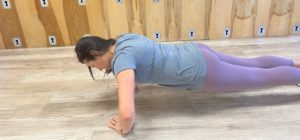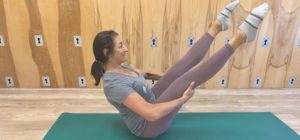5 Best Pilates Exercises for Tennis Players
Many people enjoy playing tennis both recreationally and professionally and although it is a really enjoyable sport, it’s important to take note that tennis is physically demanding. As a tennis player, you need exercises that focus on flexibility, cardiorespiratory endurance, general strength, and muscular endurance. You also need good strength and stability in the core and shoulder girdle in order to control the racket in your hand. This is super important to not only be good at the game, but without this foundation, your body cannot fully control the elbow and wrist, which can lead to additional injuries.
Core Strength Is A Major Asset For Tennis Players
Pilates is a great comprehensive exercise program that not only helps tennis players improve their ability to play, but also helps to reduce the risk of injuries. One of the main focuses of Pilates is strengthening the core because it is a key component to all movements the body makes. There are so many major benefits to a strong core including:
- Stabilization during quick movements
- Improved balance
- Increased power and momentum which in turn improves a players swing
- Reduced risk of injury.
When the body can rely on a strong core, it is less likely to pull energy from weaker, less used muscles which greatly reduces your risk of injury. Tennis players are also susceptible to muscle imbalances because they generally use one side of the body more than the other. Pilates helps to strengthen muscles from the core to the extremities and works to balance out the use of your muscles and correct imbalances.
Don’t Neglect the Importance of Breath Work
Another big focus of Pilates is breathing. Breath work is so important in tennis, and all sports, because by focusing on breathing there is an overall increase in oxygen supply in the body which helps to build endurance. Focused breathing can help the body’s ability to stretch, maintain control and improve range of motion. It also helps to develop better coordination by improving balance and concentration, all things that we’ve already pointed out are beneficial to tennis players. Breathing during exercise also helps to nourish the muscles being worked during the inhale and release the unused gasses and chemicals during the exhale.
5 Best Pilates Exercises
So now that we’ve covered why Pilates is so great for tennis players, let’s take a look at which exercises will give you the results you’re looking for.
Pilates Push-Up
PIlates Push up – This is a total body exercise so it really brings a lot of value to your workout session. Your legs and core are used for stability while also strengthening the upper body.
To perform this exercise:
- Start in standing position
- Begin by gently dropping your head and letting the weight of your head pull your body down, rolling down slowly vertebrae by vertebrae and pulling your abs in and curving your spine until your hands reach the mat/floor.
- Inhale and walk your hands forward until you are in a plank position. Hands should be directly under your shoulders, your legs straight and your hips, shoulders and ears all in line.
- Exhale as you hold the plank position.
- Inhale as you lower your body toward the ground to perform a push-up. Exhale as you extend your elbows and lift your body back up and complete the push-up. Keep your abs tight and core engaged throughout this movement.
- Inhale as you walk your hands back toward your feet and allow your spine to curve again.
- Exhale as you use your ab muscles to slowly return your body to a standing position. Be sure to roll up vertebrae by vertebrae.
- Repeat this exercise 3-5 times.


Modification: If needed, you can bend your knees as you are rolling down from standing to get your hands to the mat. You can also do the push-up on your knees or place your hands on a desk or counter or any elevated surface to perform the push-up at angle.

Hip Twist
Hip twist aka Hip circles – This exercise targets your abdominals and back extensor muscles while also working to open your chest and front of your shoulders. It also targets your obliques and lower abs.
To perform this exercise:
- Begin in a seated position with legs extended in front of you and hands placed behind you with fingertips facing away from your body.
- With your torso at a 45 degree angle, lift your legs as high as you comfortably can. Keep your core muscles tight and engaged.
- Inhale and move your legs to the left.
- Exhale and circle your legs, bringing them down toward the mat and then back up to the starting position.
- Now reverse the motion and repeat to the right. This is a very controlled movement and should not be done quickly. Make sure your back does not arch during the exercise.
- Repeat exercise 3-5 times.
Modification: If you find this position difficult to maintain, you can perform this exercise propped on your elbows instead of keeping arms straight.
Side Bends
Side bends – This exercise strengthens your abs, obliques and shoulder stabilizers.
To perform this exercise:
- Sit sideways on your left hip with legs bent to one side, right (top) foot placed in front of the left (bottom) foot. You can also stack your feet one on top of the other. Your left hand should be in line with your hip and a few inches in front of your shoulder.
- Inhale and with your left arm in the correct position, straighten your legs and lift your hips off and mat and toward the ceiling until you make an arc with your body as you straighten your right arm overhead.
- Exhale and slowly lower your hips and bend knees to return to the starting position.
- Repeat 3-5 times and then repeat while sitting sideways on your right hip.


- Starting in the same sideways sitting position (on left hip), take your right hand and hold your right ankle for balance.
- Stretch your left arm straight up above your shoulder so that there is a straight line between left hip and left hand.
- Let your left arm fall over your head and reach your body toward your right. You should feel a stretch in your left ribs.
- Extend your left arm straight up again and then bring left hand down to the mat, fingers pointing away from you.
- Engage your core muscles and then lean to your left side, let your left elbow bend come onto your left forearm as you stretch to your left side.
- Push up from your left side using your core muscles to assist with the movement and return to center.
- Come onto your knees and then switch to your right side.
- Repeat exercise on the right side. Complete this exercise 3 times per side.
Modification: If this is too challenging, a similar exercise to try is the Mermaid –
Spine Twist
Spine twist – This exercise increases range of motion in your upper body which is important in tennis. It also promotes good posture. It targets your abs and upper spine.
To perform this exercise:
- Start by sitting tall with legs straight out in front of you and arms extended out to the side. Be sure to sit tall, relax your shoulders and elongate your neck.
- Inhale and slowly twist from your waist to the right. Focus on your right hand as you twist. Twist as far as you comfortably can and keep your arms in a straight line.
- Exhale and slowly return to center.
- Inhale and twist to the left and repeat steps 2 and 3.
- Repeat exercise for 3 sets.


Open Leg Rocker
Open leg rocker – This exercise is good for balance, core strength and stability as well as spinal mobility/stretching the muscles of the back. It also targets your entire core. Make sure you have a padded surface to protect your spine.
To perform this exercise:
- Start by sitting tall with knees bent and bottoms of your feet touching.
- Place your hands on your ankles (or calves if it is difficult to reach your ankles) and then lean back until your feet are off the ground and toes are pointed toward the mat.
- Extend one leg, get your balance, and then extend the other leg. If this is difficult you can keep your knees bent.
- Inhale and keep your abs engaged as you roll back. Only go as far as your shoulders, do not roll onto your neck to avoid injury.
- Exhale and use your abdominal muscles to return to an upright position.
- Hold position and balance.
- Repeat exercise 6 times.
Modification: If straightening your legs is difficult, you can begin with your knees bent, straighten them as you roll back and then bend them as you return to an upright position.
Enoy these pilates exercises and let us know how they go for you!